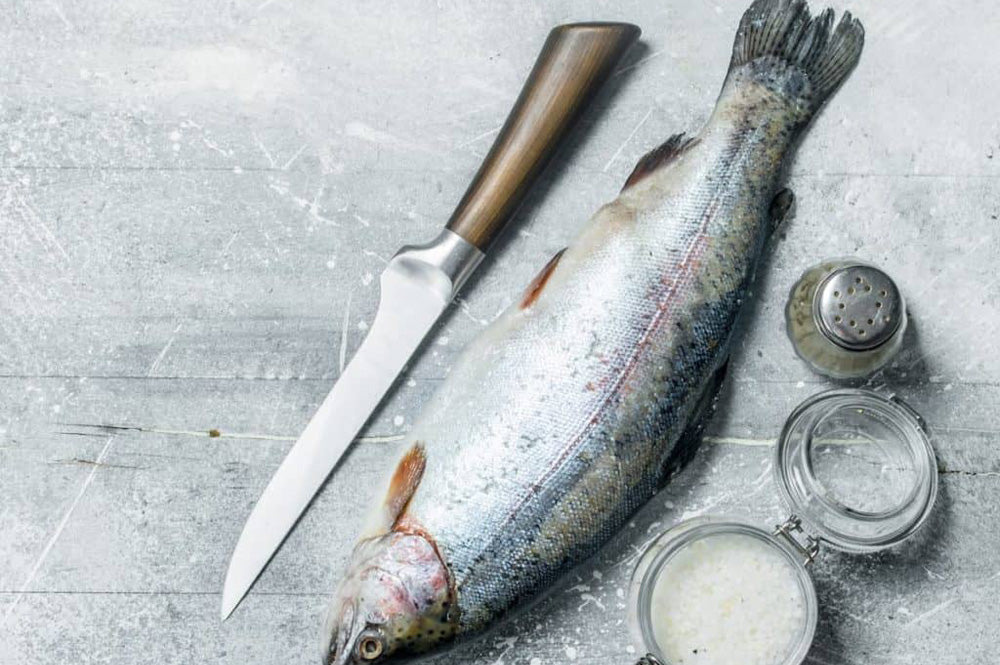Your Cart is Empty
Free US Shipping
Free US Shipping

Professionals and home cooks alike use fillet knives, and one thing everybody will agree on is that a fillet knife needs to be flexible. Fillet knives come in different shapes and sizes; you even get electric fillet knives! These knives should not be mistaken for boning knives which are less flexible.
A fillet knife needs to be flexible to ensure precise cutting. Fillet blades need to cut the meat from around a bone, as well as remove the skin from the fillet without damaging it. The blade must be flexible enough to make small, intricate cuts that can not be achieved with a rigid blade.
In this article, I will discuss why a fillet knife needs to be flexible, how flexible a fillet knife should be, and the difference between a boning knife and a fillet knife. I will also outline which fillet knives are the best for your cooking needs.
A fillet knife needs to be flexible so that the chef can make clean, precise cuts.Fish bones are thin and brittle; a thick, hard knife will not cut the fish fillet cleanly from the rib cage. In addition, a thin, flexible blade is needed to remove the skin from the fillet.
The flexibility and length of a fillet knife make it possible to cut and prepare fish easily. It also helps keep the person using the blade safe when skinning the fish, as it can bend and create space between the fillet and the skin.
You can watch this informative YouTube video if you are interested in learning how to skin and fillet a fish using a fillet knife:
Fillet knives need to be flexible and sharp so that they can easily cut through fish and remove the fillet from the bones and skin.
Good quality fillet knives are made from stainless steel and have a medium hardness. They also have a very thin blade. A thicker blade will have less flexibility, whereas a thinner blade will have more flexibility. This flexibility ultimately makes it easier to handle.

Good quality fillet knives should have a flex of at least 15% and need to bend an inch both ways when under pressure. This flexibility improves the overall handling experience of the knife.
Many people get confused when it comes to boning knives and fillet knives. Both of these knives have extremely sharp blades and need to be made from good quality steel. However, they are not used for the same purpose.
Fillet knives have curved blades and are flexible so that they can make cuts easily and precisely. Boning knives have straight, strong blades and are less flexible. They are used to cut meat from bones and are generally bigger than fillet knives.
Fillet knives are curved to help you cut through the fish in one smooth motion. The curve and flexibility of a fillet knife allow for clean cuts and easy removal of skin so that no fish goes wasted.
If you try filleting a fish with a thick and straight blade, you will not be able to get silky smooth fillets. The skin will stick to parts of the meat, and it will be difficult to remove the meat from the small brittle fish bones.
You will have to sharpen your knife if you use it often, and you want to make sure that you do it right. If you are unsure as to how to sharpen your knife, you can watch this instructional YouTube video:
If you are looking to buy a good quality fillet knife, you might be wondering which one to go with. There are many fillet knives available, and investing in the right one is essential if you want to create perfect fillets.

I have created a list of some of the best fillet knives to help you decide.
Electric fillet knives are similar to normal fillet knives, and make it even easier to cut your fish.
Fish industry workers often use eclectic fillet knives as they have to clean and fillet a tremendous number of fish at a time.
Here are some electric fillet knives that will help you become the best chef you can be.
When buying a fillet knife, you usually get a sheath with your purchase. A sheath helps to protect your knife and keeps the thin edge from chipping. You can also purchase a knife holder to store your fillet knives.
Always keep your knife in a sheath when you are not using it to prolong its lifespan. Some sheaths also have belt clips to carry your knife with you. This is perfect if you are heading out on a fishing trip and may need to fillet some fish on the go.
It is crucial to have a flexible and sharp fillet knife to skin and fillet fish. A good quality fillet knife will be made from stainless steel and be able to bend at least an inch without breaking.
Fillet knives are curved to assist in getting clean, smooth cuts. They should not be confused with boning knives, which are less flexible and have a straight blade. Remember to always store your fillet knife in a sheath to protect its fine blade.
Chef's Vision is an Amazon Associate and earns from qualifying purchases.